I can't help it either, I too move from château to château from time to time - from royal house to royal house in the "wine world" of Bordeaux. Usually not alone, but organised in a group, right now with about twenty wine friends from Germany: château tourism!
All five "Premier cru classé" (1855) are ticked off; now in autumn, when the new wines are in the making, mostly in the middle of malolactic fermentation. It is quiet at the wineries, the vineyards are being tidied up, the clouds of smoke drift over the golden-yellow sparkling sea of leaves, the autumn sun warms the soil once more and gives strength for the winter season.
On "Margaux" we are greeted by an always friendly, smiling, "distinguished" lady. Sympathetic, she seems to know everything, to know everything, even us impatient wine lovers who always want to see everything immediately, know everything, experience everything. The stressful period is now over for castle tourism, too, and visitors (registration is always a prerequisite) have become more sparse. Nevertheless, a visit to the castle takes a good hour and a half, including wine tasting.
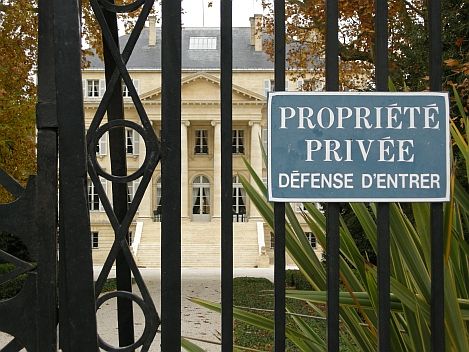 |
| The magnificent manor house of Château Margaux appears forbidding and closed. |
It is always the same, long familiar ritual. As a rule, the same elegant lady always welcomes visitors to Margaux: she is Norwegian and seems to me like the lady of the castle herself. Of course, she is "only" the "escort and receptionist", but - you can feel it - she knows her way around the winery and identifies herself completely. The procedure is standardised, there are hardly any surprises, not even when it comes to questions from overly inquisitive visitors.
You are guaranteed not to see a cellar master, an administrator, an oenologist or even an owner. These châteaux - no matter how stately they are built - are not home to winegrowers or winegrowing families. Capital lives here. The owners and investors live elsewhere, where business is done, in Paris, in London, in.
Of course, the owner has a name here too: Corinne Mentzelopoulos, the daughter of a naturalised Greek who bought the "Margaux" estate in 1977. Until four years ago, Fiat owner Giovanni Agnelli also held a good 70% stake in the listed company, but his heirs sold their shares.
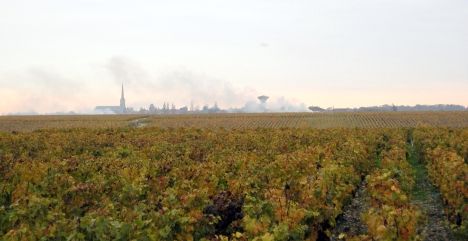 |
| View from Château Latour over the autumn vines to the village of Pauillac |
Nevertheless, as a visitor to Château Margaux, you have the feeling that you are visiting a winery and not just a wine factory. Even though everything is big and powerful: first of all the closed, dominating manor house, but then also the wooden fermentation tanks, the storage halls, the two romantic-looking cellars, the catacombs with old wines, the barrel cooperage gives the impression of small craftsmanship, the few employees who are now working in the cellar, the leaf blower who cleans the place - all this gives the feeling of a manageable, stately winery that has a soul.
Further north, we visit the two Rothschild estates the other day. They play in the same league in the global wine business, judging by the primeur prices of well over 500 euros. "Mouton" is more like a "factory" where wine is made. Everything is beautiful, perfect, refined, but far more impersonal, even more regulated. You can smell the business more than the wine: no photos in the museum, no entry there, quickly passed through here. There is also a "factory shop" where, in addition to souvenirs, a few individual bottles can be bought.
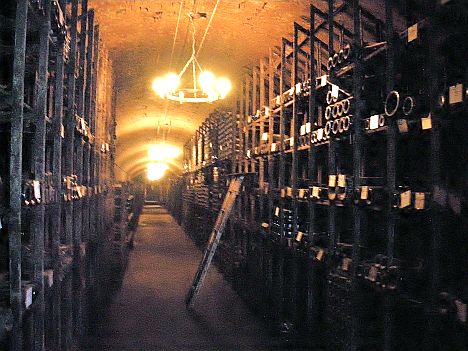 |
| The catacombs of Mouton Rothschild with the Réserve of the house. |
Here, too, you are greeted by "receptionists", well trained but interchangeable, they do their job, even well, but probably always tell you the same thing. What is different here, what is the same? The differences become blurred or are only apparent to connoisseurs. Only the obligatory introductory film radiates a bit of personal winemaking philosophy in addition to business acumen: after all, Philippine Rothschild, who welcomes visitors to the film, was an actress before she took over her father's legacy.
And something else is different: the tasting. A trained sommelier presents barrel samples of "Armailhac" (belonging to "Mouton"), "Petit Mouton" and "Mouton" (first wine). He talks about the character of the wines in such a differentiated and credible way that even a layman can make sense of it. The more experienced wine connoisseurs may even succeed in assessing the potential of the barrel samples.
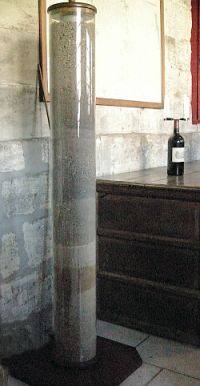 |
| The Soil Layers% presented at Château Lafite Rothschild |
The "sister estate", Lafite-Rothschild, owned by the French line of the Rothschilds, has an even more chequered history. It presents itself as much more traditional, but also more static than the "Mouton", which lies further south. There are no charming "receptionists" to guide you through the winery, but a gentleman who introduces himself as "winemaker". You get the feeling that he didn't have to learn anything by heart. Accordingly, his explanations and comments seem much more authentic than those of all the other Premiers. The presentation is less about show effects and anecdotes than about facts that determine the wine of "Lafite". For example, the microclimate, the stratification in the soil, the methods of vinification
$$BILDU keller923.jpg,The catacombs of Mouton Rothschild with the Réserve of the house,351,468$$
The crowning glory of the tour is the circular cellar by star architect Ricardo Bofill, still presented as the only circular wine cellar in the world (which is not true, as we encountered a copy in China on "Great Wall"). In the atmospheric cellar, we are offered - also very professionally - a mature "Lafite", decanted a good three hours ago: So it's not just a tasting of a wine that is still far too young, but a half-glass of wine enjoyment.
"Latour" - actually the primus among the wine kings - exclusively shows its new, ultra-modern facilities: no pumps, only the technology of gravity is used, every detail in the cave is computer-monitored and -controlled: technology of the super class. But I have the feeling of not being very welcome, rather kindly tolerated and always - as if casually - closely monitored. Here, great experience, a wonderful terroir, a proven tradition, a lot of knowledge, an excellent reputation and state-of-the-art facilities seem to have married with lots and lots of money. The result may be excellent - we were able to taste a "Pauillac" (third wine) 2006, a "Les Forts de Latour" (second wine) 2003 and a "Latour" 2001. The lady could not say much more about the wine than the exact composition of the vine shares. Then it was 12 o'clock, lunch break, and we are politely bid farewell - as if driven by a factory clock. Au Revoir!
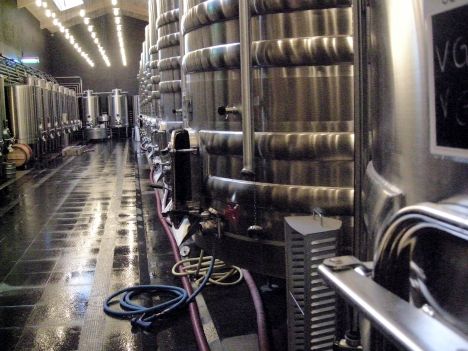 |
| The most modern fermentation tanks at Château Latour |
The fifth in the bunch, actually my favourite, is Haut-Brion in Pessac Léognan. The proud estate could only half reconcile me: Again, this charming, well-schooled escort lady. The usual tour of the tank rooms, the cave, but the impressive cellar with the "Reserve de la Maison" remained closed. Much more important was the repeatedly told story - now 72 years old - of the American banker who actually wanted to buy Cheval Blanc, but got lost in the fog at "Haut-Brion" and then acquired this very vineyard.
But the staff was halfway excused, because the evening before, the traditional end-of-harvest party was celebrated at Haut-Brion, with all the employees. So - at least for that one day - the "air was out"!
However, the "appendage" was still sensational: a short visit to the renovated and completely new Château Mission Haut-Brion. It belongs to the same winery and is located on the other side of the road.
This last flying visit reconciled me with all the routine and the many show effects that are inherent even in out-of-season, late-autumn castle tourism.
Sincerely
Yours/Yours Peter (Züllig)